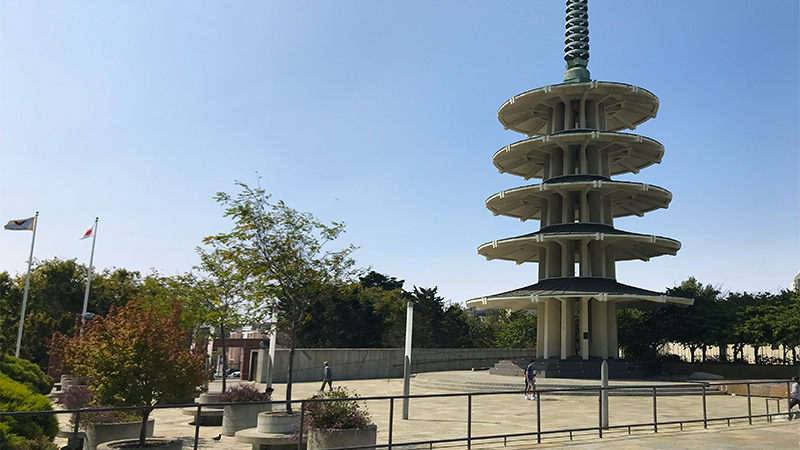
While bustling Chinatown tends to overshadow Japantown in terms of San Francisco tourism and general awareness, it’s definitely not a neighborhood to be missed.
In all the years I have been visiting San Francisco on day trips and weekend getaways, I had never been to Japantown. Honestly, I really didn’t even know it was a tourist destination or a thing until I discovered Crown & Crumpet, a tea house that relocated from Ghiradelli Square to Japantown back in 2013.
I was so excited for the opportunity to explore the neighborhood and check out somewhere new.
Only three Japantowns still remain in the United States: Japantown in San Jose, Little Tokyo in Los Angeles, and Japantown in San Francisco. Of the three, San Francisco’s Japantown, the center of the San Francisco Japanese community before World War II, is the oldest and largest.
San Francisco’s Japantown (Nihonmachi) is a six-square-block neighborhood bounded by Geary Boulevard, Fillmore Street, Laguna Street, and Sutter Street that invites you to immerse yourself in the Japanese American culture. This small, unique area is jam-packed with shops, restaurants, and things to do and see, including:
- Japanese Peace Plaza: Located in the heart of Japantown, the plaza features Cherry Blossom trees and the 1968 Peace Pagoda, a five-tiered concrete shrine designed by Japanese architect Yoshiro Taniguchi. It was a gift from Osaka, San Francisco’s sister city in Japan.
- Origami Fountains: Two waterless fountains, also called the Buchanan Mall fountains, in the outdoor mall created by sculptor Ruth Asawa.
- Cottage Row: A tiny neighborhood park between Bush Street and Sutter Street that features a row of homes that date back to the mid-19th century.
- Nijiya Market: A supermarket with a diverse assortment of Japanese candies, jams and sauces, fish, and bento boxes.
- The New People Building: A three-story building with New People Cinema showing Japanese anime movies and Crown & Crumpet serving tea, an escape room, and shops selling Japanese Lolita wear and split-toe tori shoes.
- Annual Festivals: Japantown is home to many annual events, including the Northern California Cherry Blossom Festival and the Nihonmachi Street Fair.
Kinokuniya Bookstore: The largest bookstore chain in all of Japan selling Japanese books, magazines, comic books, CDs, DVDs, software, stationery, specialty gifts, and more, opened its first overseas store here in 1969.
You also can’t visit Japantown without walking through the Japan Center Malls. The two-story Japan Center Malls, East Mall (Miyako), West Mall (Kintetsu), and Kinokuniya Mall, run in a row along Post Street, between Fillmore and Laguna Streets. The malls were built in the 1960s and have a very cool, distinctly Japanese atmosphere where Japanese restaurants and bars, specialty grocery stores, and shops of all kids are mixed together just begging to be explored.
These partially underground and outdoor malls provide a unique Japanese shopping experience where you can buy everything from dishware, tea supplies, stationery, and home decor to bonsai trees, jewelry, car parts, books and magazines, backpacks and items for kids, vehicle accessories, beauty products and hair accessories, kimonos, swords, and paper art.
We really enjoyed wandering through the malls before our tea reservation and even found some treasures. We all bought hats to wear to tea, I bought some beautiful dishes, and Natalie found awesome Christmas presents for all of her friends at Daiso, the $1.50 store that only sells Asian brands.
San Francisco Japantown History
The first Japanese arrived in San Francisco in the early 1860s and mostly lived in Chinatown and neighborhoods south of Market Street. It wasn’t until the devastating 1906 earthquake and fire that many Japanese and Japanese Americans relocated to the current central Japantown neighborhood location just one mile from Union Square.
Here they built churches and shrines and opened Japanese shops and restaurants. As San Francisco’s Japanese American community took root, the 30 block area became known as Japantown or Nihonjin Machi, the Japanese People’s Town and was one of the largest populations of Japanese outside of Japan.
In 1942, President Franklin D. Roosevelt signed Executive Order 9066, forcing all Japanese by birth or descent, including Japanese Americans, into internment camps. These communities were suddenly uprooted and interned in what was one of the great tragedies of the World War II. Following the War, many of the original Japanese American residents returned to the city to pick up the threads of their lives. Today, nearly 12,000 Japanese Americans live in San Francisco and approximately 80,000 live in the greater Bay Area.
Know Before You Go
- San Francisco’s Japantown (Nihonmachi) is a six-square-block neighborhood near the Fillmore District that is bounded by Geary Boulevard, Fillmore Street, Laguna Street, and Sutter Street.
- Japan Center Main Garage is located at the Japan Center Malls at 1610 Geary Boulevard, San Francisco, CA 94115 and the Japan Center Annex Garage is located at 1650 Fillmore Street, San Francisco, California 94115.
- Need a place to stay in Japantown? Check out Hotel Kabuki. We wandered through their lobby and it’s got a super cool vibe. Next time we’re in the area, I’m definitely going to stay there.
- The San Francisco Japantown History Walk is a self-guided tour following of 16 interpretive signs along a ten block route through the heart of Japantown and providing visitors with a unique insight into the community’s history and culture.








